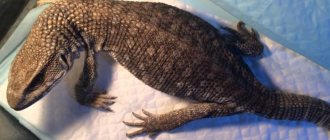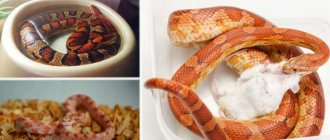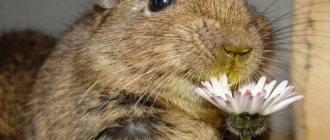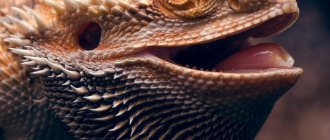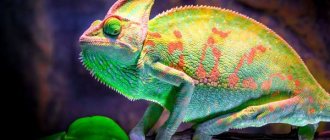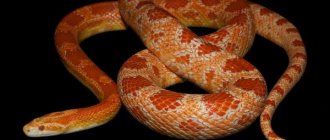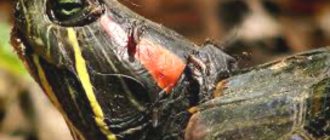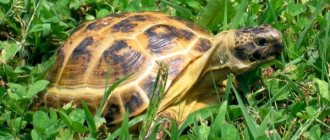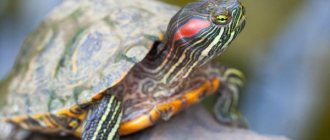Gecko - a small lizard that lives in subtropical and tropical areas. She has amazing limbs. The animal's paws are covered with many hairs, thanks to which the lizard can walk on vertical surfaces, such as walls, window panes and even the ceiling. There are a large variety of geckos. They differ from each other in color, size and body structure.
Description and external features
The size of African lizards can vary from 3 to 30 centimeters. The eyes are protruding and large. A characteristic feature of the appearance is the absence of eyelids.
The skin of geckos is delicate and sensitive, and is therefore covered with protective scales.
The lizard's tail is thin and has the ability to regenerate.
The lower part of the paws is covered with numerous hairs, thanks to which the gecko can move easily and freely on both horizontal and vertical surfaces.
The color is bright and changing, depending on the time of day, the condition and mood of the animal.
Geckos are primarily nocturnal.
One of their most interesting features is the ability to produce a wide variety of sounds.
Water
The terrarium must be kept fresh and clean at all times. Pour into a not-so-small shallow bowl, and you might enjoy watching your leopard gecko lap up the water with its graceful tongue, like a rose petal. Or you will be lucky enough to see how this handsome man takes a bath in the heat. They do this rarely and not all individuals do. But trample in a bowl of water with all your paws, and then with the same paws be sure to get into the calcium - many mischievous people love this. You can spray the walls of the terrarium; some lizards like to lick droplets from the walls.
Conditions of detention
To keep a gecko at home, you need to purchase a spacious, not too high, horizontal terrarium.
The ideal soil option is gravel or sand. It is important to take care of sufficient moisture in the terrarium.
Since African lizards need periodic solitude, shelters should be placed at the bottom, which can be either special houses or improvised objects (for example, halves of a coconut).
A drinking bowl with clean water should always be present in the terrarium.
To maintain a suitable microclimate, it is recommended to install pots with greenery.
Optimal temperature indicators range from +19 to +34 C. Moreover, in the daytime, the temperature should be slightly higher than at night. An incandescent lamp will help provide the necessary heating.
Recommended humidity levels are about 70-80%. To moisturize, the terrarium should be sprayed periodically, using fresh water for this purpose.
Despite the fact that reptiles are nocturnal, a fluorescent lamp must be installed next to the terrarium.
It is necessary to irradiate lizards with ultraviolet light at least 1–2 times a week, otherwise their health and appearance will noticeably deteriorate.
In their natural environment, geckos live in small colonies and do not tolerate loneliness well. For this reason, it is recommended to keep them at home in pairs.
The best option is 1 male and several females.
But it is strictly not recommended to place 2 males in one container, since the fight for territory leads to serious fights and, in most cases, ends in the death of one of the animals.
Currents
This is a fairly large lizard. Toki gecko (adult) reaches 35 cm in length. Males are brighter colored than females. Their backs can be olive, gray or dark green, with white patches that turn into stripes on the back. The eyes are large with vertical pupils. The body is dense, slightly flattened. The head is very large, powerful but short legs. The tail is not too long.
The toki gecko is common in tropical forests in southeast Asia. This reptile gives the deceptive impression of a clumsy creature. In fact, she is very active, especially at dusk. Toki are aggressive towards their fellows. Strangers are not allowed into their territory. They declare their right with a loud cry.
Feeding
The gecko is a predator by nature. When learning how to keep an exotic pet at home, you should pay special attention to nutritional issues. The basis of the diet of an African lizard in captivity should be:
- Crickets.
- Mealworms.
- Cockroaches.
- Flies, spiders.
- Small rodents.
It is recommended to dilute live food with berries, cottage cheese, fruits, and quail eggs.
Geckos should be fed no more than 2 times a week.
It is strictly not recommended to overfeed your pets. Overeating has an extremely negative impact on the health of the reptile, leading to apathy, decreased motor activity, the development of a number of diseases and causes the animal’s premature death.
Where to buy a gecko
Every store selling animals has a selection of reptiles. The gecko is a popular lizard, so their choice is always quite varied. In Moscow, we advise you to contact the Gekko terrarium workshop. This is a specialized pet store that deals exclusively with terrarium animals. In addition, here you can pick up all the necessary equipment and accessories for keeping reptiles. These include terrariums of different sizes from different manufacturers, lamps, heating devices, and heating mats. Here you will be offered various types of soil, select plants, drinking bowls and waterfalls, and select dry and live food. In the Russian capital, you can go to the Happy Gecko Farm nursery for lizards; in St. Petersburg, you can go to the Living Water salon or the Priroda store. There you can buy everything you need for these pets.
Character and communication with your pet
When planning to have such an unusual, exotic pet, you should remember that African lizards are wild predators.
They have strong jaws and sharp teeth that are difficult to open without damaging them.
Geckos have a hard time with intrusion into their personal space and can become aggressive, swell and hiss loudly.
It is strictly not recommended to try to pick them up at such moments, as this may result in injury.
However, the gecko gradually gets used to the person who cares for it and gives it food. However, you should not hold your pet too often, so as not to provoke the development of severe stress.
When caring for or interacting with an animal, you must be especially careful with the tail, which, due to its natural thinness and fragility, can come off.
In general, the gecko is a fairly peaceful animal, but you should not unceremoniously invade its personal space, especially during mating games, eating or resting.
Possible diseases of leopard geckos
Leopard geckos, like any other living beings, are susceptible to certain diseases that arise for a number of reasons.
The most common diseases of leopard geckos:
- Helminthiasis is infection by helminths. The pathology worsens with exhaustion and severe stress. Characteristic signs are refusal to eat, loose stools with a foul odor, and a decrease in the volume of the tail. Treatment is carried out with special anthelmintic drugs for lizards. It is also recommended to drink plenty of fluids to avoid dehydration.
- Rickets. The disease develops due to a lack of calcium in the body. An obvious sign is deformation and weakness of the legs; the lizard moves slowly and touches the ground with its belly. The treatment uses liquid calcium gluconate. Drops of the drug are instilled into the lizard's mouth every day for 2 or more months. Special foods containing calcium must be included in the diet.
- Fungal diseases in which grayish spots appear on the skin of the leopard gecko. Treatment is carried out only as prescribed by a doctor.
- Cryptosporidiosis is a very dangerous and practically incurable disease that affects the liver and causes the accumulation of large amounts of fluid in the abdominal cavity. With this disease, the lizard's tail noticeably loses weight, and a black spot appears on its chest. In this case, emergency assistance from a specialist is required.
- Unsuccessful molting, after which the lizard's tail becomes flabby and its tip dry. The problem can be solved simply: the diseased tail is carefully cut off, and the wound is treated with Miramistin spray or Chlorhexidine solution. This is not at all dangerous for the pet; it will soon grow a new and healthy tail.
That's all the most important thing you need to know about the rules of keeping and caring for leopard geckos. By following simple recommendations from experts, your exotic pet will live a long and happy life, delighting you with its interesting behavior and friendly disposition.
Advantages and disadvantages of keeping geckos at home
Keeping an African lizard at home is not a particularly troublesome task. These pets have the following advantages:
- Cleanliness - to maintain order in the terrarium, it is enough to clean it 1-2 times during the week.
- Absence of any unpleasant, specific odors.
- Bright, unusual appearance and interesting character, making observing the reptile extremely exciting.
- No need for frequent feeding - an adult lizard can easily go without food for 4-5 weeks.
- Friendliness and peaceful nature.
- Possibility of reproduction in captivity.
It is also important that geckos are very pleasant to the touch and do not cause allergic reactions in humans, so they can become an excellent pet for people who are allergic to cat and dog hair.
As for the disadvantages of keeping geckos at home, they usually include the nocturnal lifestyle of the reptile. During the day, the lizard usually sleeps, hides in shelters and is not active, but at night, on the contrary, it can disturb the sleep of its owners by making loud sounds.
In addition, the gecko is a fairly expensive animal, the average cost of which varies from 100 to 1000 dollars and even higher if we are talking about rare subspecies.
The gecko is a beautiful reptile that can become a real decoration of the room. Knowing how to keep such an unusual pet at home, you can admire its bright, tropical appearance and funny habits for decades.
Reproduction
In nature, individuals are ready to mate all year round, except winter. As a result, the female begins to look for hollows in trees where she can lay eggs. Most often, 6-8 clutches are obtained with a frequency of 30 days. Incubation takes from three months to six months - it all depends on environmental conditions.
Before propagation, you need to place large pieces of bark and small trunks with hollows in the terrarium. The number of offspring also depends on how many places for laying the female can find.
In order for offspring to appear, the temperature in the tank must be maintained at +30 °C. If everything is done correctly, incubation will take approximately 4.5 months. At this time, the female’s body needs as many minerals as possible, including calcium. Otherwise, she will start gnawing on the shell.
A couple of months after laying the eggs, the offspring should be transferred to a separate incubator. This is done for its protection - so that adult individuals cannot eat newly hatched ones. Insect larvae and crickets are suitable for feeding small Geckos.
Safe insects
Spotted favorites will eat any insect that appears before their keen hunting eyes. However, not all living things will be useful and safe for them.
The most harmless are crickets, which are sold in pet stores. They are specially reproduced for food, so you don’t have to worry about the quality of such food. You just have to make sure that the individuals are not large, otherwise the reptile’s body will not be able to digest them.
A couple of times a week, leopard geckos can be fed Zophobass as an additional source of nutrition. It is also available in pet stores. There is no need to offer zofobas more often - lizards quickly get used to them, and an excess of such food can lead to obesity.
Silkworms serve as excellent food. However, they are difficult to find and they are expensive. Moreover, silkworms have a short life cycle, so it is not possible to purchase them in reserve.
How long can he live without food?
A little hunger is much better than overeating. The lizard's lush tail, which has accumulated a lot of nutrients, will serve as a source of nutrition in the event of even a two-week break in feeding. The reptile's body will feed on reserves from the tail, which will even benefit particularly well-fed individuals.
The tail for a lizard is not only a storage of nutrients, but also a reserve of fat for the winter.
There is nothing complicated or impossible in the rules for feeding spotted leopard geckos. Correct and healthy food, taken according to the regime within acceptable limits, will preserve all the unique external properties, as well as the natural behavioral instincts of these amazing animals. By following all nutritional recommendations, your pet dragon will always be healthy, alert and active.
Have you kept a leopard gecko? Share your secrets of feeding baby dragons with beginners in the comments.
Physiology.
The male is larger than the female, has a more powerful build, a wide neck, a massive head, the tail is thicker at the base with a number of preanal pores (a series of yellowish-brown small dots on the scales between the hind legs) and bulges behind the cloaca. It takes about six months to reliably determine the sex of a leopard gecko. The sex of leopard geckos directly depends on the temperature during egg incubation, which makes it possible to obtain offspring of the required sex with a high probability.
Sexual maturity usually occurs at the age of 9 months, but sometimes earlier and sometimes later. Females weighing at least 45g should be allowed to breed. If a female becomes pregnant before she is fully formed, this can lead to death, delay or stop of her physical development.
The coloring of leopard geckos is sometimes simply incredible. If nature endowed them with a fairly dark color - almost black spots and stripes on a yellow-gray background - then breeders are still getting new morphs to this day. Yellow, orange, pink, white, black, with and without patterns, with stripes and dots - hundreds of fantastic colors (they even tried to bring out blue, but so far not very successfully). The color of the eyes is also amazing - ruby, orange, black, with snake pupils and even marble. Plunging into the world of leopard gecko genetics, you will go on an amazing journey, where at each end point a new incomparable baby will be waiting for you! Therefore, the leopard gecko is not only an interesting animal for amateurs, but also captures the imagination of sophisticated professionals.
Leopard geckos will always be healthy if they pay proper attention to these underlying health issues and understand when they can help on their own and when they need veterinary help.
Based on an article by Elsa, Massachusetts, Boston Translation by Roman Dmitriev Original article on the website: https://www.happygeckofarm.com You can buy the Spotted Leopard Gecko here:
Treats
Geckos often change their tastes as they grow older. At one time they feed only on crickets, and then categorically refuse them and prefer other food. Therefore, it is better to alternate the menu for adult animals.
For variety, you can offer locusts, hawk moths, moth larvae, zoobass, and mealworms as delicacies. This is a very high-calorie and fatty food; you can pamper your pets with it only a couple of times a month.
After laying eggs, females are given mouse babies - pebbles. This is the most nutritious food that will help restore their strength and replenish nutrients in the body.
Hawkmoth caterpillars are a treat for leopard geckos
Cleaning the terrarium
Clean the water section of your lizard's tank daily. Your pet will likely go into hiding in another corner of the tank, so it will be easy to just scoop up any solid waste with a small scoop. Also, remove the wet substrate.
Clean and disinfect the tank completely weekly. In this case, you need to remove the gecko from the tank and place it in a reserve tank or some other container from which it cannot escape. Wash your hands; you can also wear disposable gloves. Remove everything from your home. Clean the aquarium with hot, soapy water, or you can use a scraper. Use lizard disinfectant. Follow the manufacturer's instructions. Make sure everything is completely rinsed with water and completely dried. Always wash your hands well with hot, soapy water after cleaning your lizard's tank. If you have used gloves, it is best to throw them away.
Does it need to be washed?
Don't bathe your gecko unless necessary. They do not require bathing unless they are very dirty, have skin problems, or suffer from an ailment for which a veterinarian has recommended bathing.
Pour warm water about 30 degrees Celsius approximately 2 centimeters deep. Add a drop of medicine or mineral oil if prescribed to you. Place your pet in the water. Gently pour water onto your back. Once he is completely wet, you can use a cotton pad to gently wipe his skin. Don't rub too hard and never try to remove flakes of skin. If his skin is very flaky, you can scrub lightly with a soft toothbrush. Use a dry cloth or paper towel to dry your gecko.

